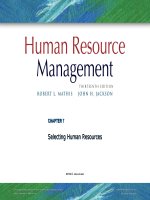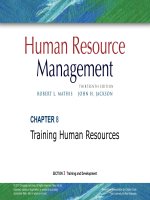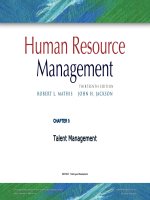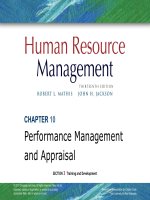Human resrouce management 13th mathis jacson chapter 02
Bạn đang xem bản rút gọn của tài liệu. Xem và tải ngay bản đầy đủ của tài liệu tại đây (1.82 MB, 36 trang )
CHAPTER 2
Strategic HR Management
and Planning
SECTION 1 Environment for Human Resource Management
© 2011 Cengage Learning. All rights reserved. May not be
scanned, copied or duplicated, or posted to a publicly
accessible Web site, in whole or in part.
PowerPoint Presentation by Charlie Cook
The University of West Alabama
Chapter Objectives
After you have read this chapter, you should be able to:
• Summarize the strategic planning process and how it drives
the organizational activities.
• Outline how strategic HR management is linked
to the organizational strategies.
• Discuss how internal and external environmental factors
affect HR strategies.
• List HR strategic challenges faced by modern organizations.
• Explain how technology is affecting HR management
practices and employees.
• Identify how organizations can measure and assess
the effectiveness of HR management practices.
Strategy and Strategic Planning
Strategy
Strategic Planning
The proposition an
organization follows for how
to compete successfully and
thereby survive and grow.
The process of defining
organizational strategy and
allocating resources toward
its achievement.
FIGURE 2–1
Strategic Planning
Process
Strategy Formulation
Organizational Mission
Strategic HR Management
The guiding force and core
reason for the existence of
the organization and what
makes it unique.
The use of employees to gain
or keep a competitive
advantage, resulting in
greater organizational
effectiveness.
FIGURE 2–2
Traditional HR
versus
Strategic HR
Strategic Competencies for HR Professionals
Credible Activist
Culture and Change Steward
Challenges assumptions and
offers a point of view
Shapes the organizational
culture, makes changes
happen
Talent Manager/Org Designer
Strategy Architect
Acquires and deploys talent,
embeds capabilities into the
organizational structure
Recognizes trends, forecasts
obstacles to business success,
and builds overall strategy
Operational Executor
Business Ally
Efficiently and effectively
carries out tactical HR
activities
Understands the business
value chain, and establishes
internal partnerships with line
managers
Operationalizing HR Management Strategies
Thinking
Strategically
Understand
the business
Focus on key
business goals
Know what
to measure
Prepare for
the future
FIGURE 2–3
Strategic Human
Resource Management
HR As Organizational Contributor
HR Contributions to
Organization Effectiveness
Organization
productivity
Customer service
and quality
Financial
contributions
High-Performance Work Practices
Incentive Compensation
Training and Development
Employee participation
Selectivity in Hiring
Flexible Work Arrangements
High
Performance
Organization
HR Effectiveness and Financial Performance
• Effectiveness
The extent to which goals have been met.
• Efficiency
The degree to which operations are done
in an economical manner.
Environmental Analysis
• Environmental Scanning
The assessment of internal and external
environmental conditions that affect the organization
Legislative/Political
Influences
Economic
Conditions
HR
Planning
Demographic
Changes
Geographic and
Competitive Concerns
FIGURE 2–4
HR Factors in the SWOT Analysis
Internal Environmental Analysis
• Succession Planning
The process of identifying a plan for the orderly
replacement of key employees.
FIGURE 2–5
Areas of External Environmental Scan
Global Competitiveness and Strategic HR
Global Framework
Global Legal
and Regulatory
Factors
Offshoring
Operations
Global
Staffing
FIGURE 2–6
Strategic Approaches to International Staffing
HR Planning in Mergers and Acquisitions
• Cultural Compatibility
The extent to which such factors as decision-making
styles, levels of teamwork, information-sharing
philosophies, and the formality of the two
organizations are similar.
• HR’s Role in Mergers and Acquisitions
Communicating decisions
Revising the organization structure
Merging HR activities
FIGURE 2–7
HR Activities during Mergers and Acquisitions
Key Factors in Cultural Fit
Degree of internal
integration
Autonomy
Adaptability
Employee trust
Diversity
Cultural Fit
in Mergers and
Acquisitions
Changing the Organizational Culture
Define the desired
behaviors
Deploy role
models
Culture
Provide meaningful
incentives
Provide clear and
consistent messages
Managing a Talent Surplus
Reduction in Work Hours
or Compensation
Attrition and Hiring
Freezes
Voluntary Separation
Programs
Workforce Downsizing
Workforce
Reductions
Legal Considerations
for Workforce Reductions
Workforce
Adjustments
Severance
benefits
COBRA
coverage
OWBPA
Warn
Act
Managing a Talent Shortage
Use
overtime
Outsource
work
Tactics to
Reduce
a Talent
Shortage
Bring back
recent retirees
Implement
alternative work
arrangements
Use contingent
workers
Reduce
turnover









